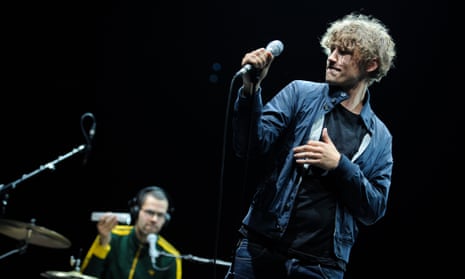German scientists are planning to equip 4,000 pop music fans with tracking gadgets and bottles of fluorescent disinfectant to get a clearer picture of how Covid-19 could be prevented from spreading at large indoor concerts.
As cultural mass gatherings across the world remain on hold for the foreseeable future, researchers in eastern Germany are recruiting volunteers for a “coronavirus experiment” with the singer-songwriter Tim Bendzko, to be held at an indoor stadium in the city of Leipzig on 22 August.
Participants, aged between 18 and 50, will wear matchstick-sized “contact tracer” devices on chains around their necks that transmit a signal at five-second intervals and collect data on each person’s movements and proximity to other members of the audience.
Inside the venue, they will also be asked to disinfect their hands with a fluorescent hand-sanitiser – designed to not just add a layer of protection but allow scientists to scour the venue with UV lights after the concerts to identify surfaces where a transmission of the virus through smear infection is most likely to take place.
Vapours from a fog machine will help visualise the possible spread of coronavirus via aerosols, which the scientists will try to predict via computer-generated models in advance of the event.
The €990,000 cost of the Restart-19 project will be shouldered between the federal states of Saxony and Saxony-Anhalt. The project’s organisers say the aim is to “identify a framework” for how larger cultural and sports events could be held “without posing a danger for the population” after 30 September.
While some German states, such as Saxony and Brandenburg, have relaxed social-distancing restrictions to the extent that medium-sized indoor concerts are allowed to go ahead, concerts with more than a thousand attendees remain banned across the country until at least the end of August.
New Zealand, which managed to control the spread of the pandemic at an early stage, allowed 20,000 rugby fans to crowd into a stadium in the city of Dunedin this weekend. An estimated 6,200 spectators attended US president Donald Trump’s campaign rally in Tulsa, Oklahoma, on 20 June.

Elsewhere, musicians and sportspersons face a precarious future as the fear of “super-spreader events” makes many governments reluctant to allow large gatherings in enclosed environments.
“We are trying to find out if there could be a middle way between the old and the new normal that would allow organisers to fit enough people into a concert venue to not make a loss,” said Stefan Moritz, the head of clinical infectious diseases at the University hospital in Halle and the experiment’s coordinator.
To stop the Leipzig experiment from becoming the source of a new outbreak, signed-up volunteers will be sent a DIY test kit and have a swab at a doctor’s practice or laboratory 48 hours before the concert starts. Those who cannot show proof of a negative test at the door will be denied entry.
A face mask with an exhalation valve will be given to each concertgoer with the disinfectant. While organisers say these measures mean the risk of catching the virus at the concert is “extremely slim”, they also warn that 100% protection cannot be guaranteed.
By midday on Monday, 775 volunteers had signed up for the concert with Bendzko, a soul-pop singer whose 2011 debut album sold 500,000 copies in Germany.
At the Leipzig concert hall, a seating-only venue that has held sports events as well as concerts by Bob Dylan and Britney Spears, they will be asked to act out three different scenarios.
In the first scenarios, the audience will attend the concerts as they would have done in pre-virus times, entering through two main entrances before taking their seats. In the second, “optimised” scenario, the crowd will enter through eight entrances to facilitate less mingling, and every second seat on the stands will be blocked.
In the third, strictly socially distanced scenario, only 2,000 spectators will be allowed to enter the 12,000 capacity venue and be seated at a 1.5m distance from each other.
The scientists behind the concert say they hope to search through the mass of data in just over a month and present their findings in early October.
